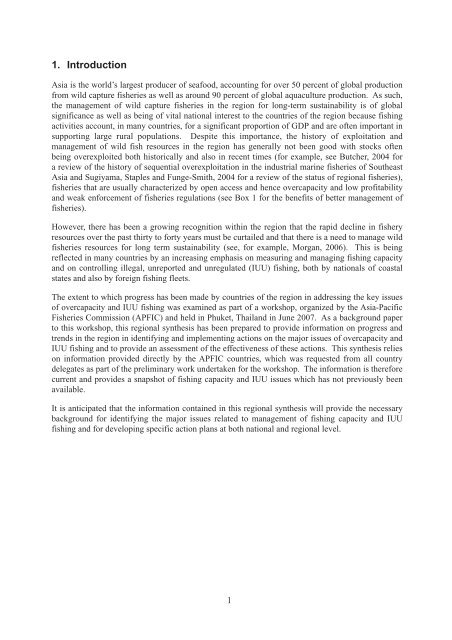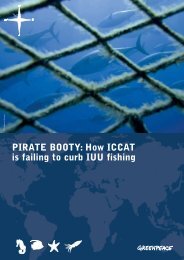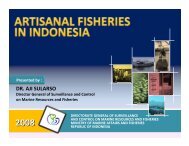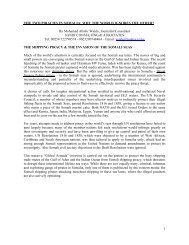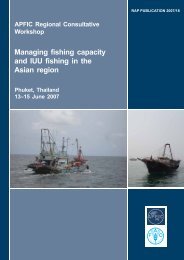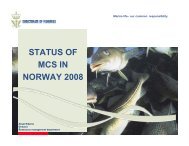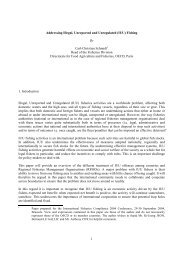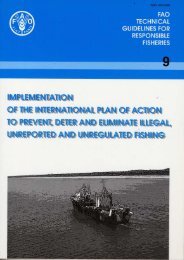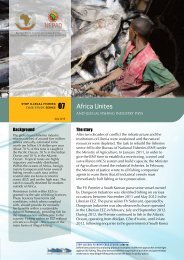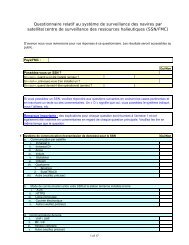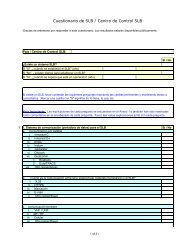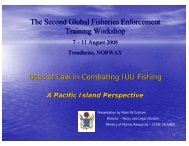Fishing capacity management and IUU fishing in Asia - FAO.org
Fishing capacity management and IUU fishing in Asia - FAO.org
Fishing capacity management and IUU fishing in Asia - FAO.org
Create successful ePaper yourself
Turn your PDF publications into a flip-book with our unique Google optimized e-Paper software.
1. Introduction<strong>Asia</strong> is the world’s largest producer of seafood, account<strong>in</strong>g for over 50 percent of global productionfrom wild capture fisheries as well as around 90 percent of global aquaculture production. As such,the <strong>management</strong> of wild capture fisheries <strong>in</strong> the region for long-term susta<strong>in</strong>ability is of globalsignificance as well as be<strong>in</strong>g of vital national <strong>in</strong>terest to the countries of the region because <strong>fish<strong>in</strong>g</strong>activities account, <strong>in</strong> many countries, for a significant proportion of GDP <strong>and</strong> are often important <strong>in</strong>support<strong>in</strong>g large rural populations. Despite this importance, the history of exploitation <strong>and</strong><strong>management</strong> of wild fish resources <strong>in</strong> the region has generally not been good with stocks oftenbe<strong>in</strong>g overexploited both historically <strong>and</strong> also <strong>in</strong> recent times (for example, see Butcher, 2004 fora review of the history of sequential overexploitation <strong>in</strong> the <strong>in</strong>dustrial mar<strong>in</strong>e fisheries of Southeast<strong>Asia</strong> <strong>and</strong> Sugiyama, Staples <strong>and</strong> Funge-Smith, 2004 for a review of the status of regional fisheries),fisheries that are usually characterized by open access <strong>and</strong> hence over<strong>capacity</strong> <strong>and</strong> low profitability<strong>and</strong> weak enforcement of fisheries regulations (see Box 1 for the benefits of better <strong>management</strong> offisheries).However, there has been a grow<strong>in</strong>g recognition with<strong>in</strong> the region that the rapid decl<strong>in</strong>e <strong>in</strong> fisheryresources over the past thirty to forty years must be curtailed <strong>and</strong> that there is a need to manage wildfisheries resources for long term susta<strong>in</strong>ability (see, for example, M<strong>org</strong>an, 2006). This is be<strong>in</strong>greflected <strong>in</strong> many countries by an <strong>in</strong>creas<strong>in</strong>g emphasis on measur<strong>in</strong>g <strong>and</strong> manag<strong>in</strong>g <strong>fish<strong>in</strong>g</strong> <strong>capacity</strong><strong>and</strong> on controll<strong>in</strong>g illegal, unreported <strong>and</strong> unregulated (<strong>IUU</strong>) <strong>fish<strong>in</strong>g</strong>, both by nationals of coastalstates <strong>and</strong> also by foreign <strong>fish<strong>in</strong>g</strong> fleets.The extent to which progress has been made by countries of the region <strong>in</strong> address<strong>in</strong>g the key issuesof over<strong>capacity</strong> <strong>and</strong> <strong>IUU</strong> <strong>fish<strong>in</strong>g</strong> was exam<strong>in</strong>ed as part of a workshop, <strong>org</strong>anized by the <strong>Asia</strong>-PacificFisheries Commission (APFIC) <strong>and</strong> held <strong>in</strong> Phuket, Thail<strong>and</strong> <strong>in</strong> June 2007. As a background paperto this workshop, this regional synthesis has been prepared to provide <strong>in</strong>formation on progress <strong>and</strong>trends <strong>in</strong> the region <strong>in</strong> identify<strong>in</strong>g <strong>and</strong> implement<strong>in</strong>g actions on the major issues of over<strong>capacity</strong> <strong>and</strong><strong>IUU</strong> <strong>fish<strong>in</strong>g</strong> <strong>and</strong> to provide an assessment of the effectiveness of these actions. This synthesis relieson <strong>in</strong>formation provided directly by the APFIC countries, which was requested from all countrydelegates as part of the prelim<strong>in</strong>ary work undertaken for the workshop. The <strong>in</strong>formation is thereforecurrent <strong>and</strong> provides a snapshot of <strong>fish<strong>in</strong>g</strong> <strong>capacity</strong> <strong>and</strong> <strong>IUU</strong> issues which has not previously beenavailable.It is anticipated that the <strong>in</strong>formation conta<strong>in</strong>ed <strong>in</strong> this regional synthesis will provide the necessarybackground for identify<strong>in</strong>g the major issues related to <strong>management</strong> of <strong>fish<strong>in</strong>g</strong> <strong>capacity</strong> <strong>and</strong> <strong>IUU</strong><strong>fish<strong>in</strong>g</strong> <strong>and</strong> for develop<strong>in</strong>g specific action plans at both national <strong>and</strong> regional level.1


